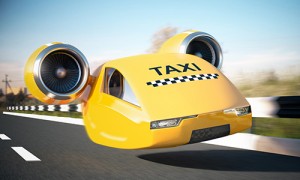 As I was driving in congested freeway traffic last weekend I realized that one of the benefits of autonomous or self-driving vehicles is they won’t have to slow down to gawk at accidents. Eliminating that human impulse alone should help smooth traffic flow. I have been thinking so much lately about autonomous vehicles that I was unaware of the development of other new types of cars until a colleague prompted me to take a closer look at flying cars. What I found just might send me to my local airport for flight lessons.
As I was driving in congested freeway traffic last weekend I realized that one of the benefits of autonomous or self-driving vehicles is they won’t have to slow down to gawk at accidents. Eliminating that human impulse alone should help smooth traffic flow. I have been thinking so much lately about autonomous vehicles that I was unaware of the development of other new types of cars until a colleague prompted me to take a closer look at flying cars. What I found just might send me to my local airport for flight lessons.
Flying Car School
The first flying car school in North America recently opened in Roosevelt, Utah. Students will learn in the PAL-V Liberty which is produced by Dutch company PAL-V. This particular vehicle can drive on a city street and then go airborne after taxiing down a short road or runway. The company is securing FAA and European approval to introduce the first commercial version in 2018. Flying one will require a full pilot’s license because of the weight of the vehicle. A thrust engine powers the flying car, along with gyro blades that help with lift and to keep it airborne. Once on the ground, the blades and rudder fold up so that it can navigate city streets and highways.
I am not sure of the maximum distance this flying car can travel on one tank of gas, either on the ground or in the air, but I am starting to think about personal applications of this technology. It would be nice to reach a rural site without having to navigate miles of gravel roads. You could also shorten a city commute considerably if you could take off from the road in front of your house and land in front of your office.
Options
Another flying car in testing or limited production is the AeroMobil, based out of the Czech Republic. They have been flying/driving prototypes since 2014 and are close to introducing a production model. Another option is the Terrafugia Transition which is being developed by a private company out of Woburn, MA. The company expects the first production vehicle in 2019. The Transition is described as a folding-wing, two seat, roadable aircraft. Even more exciting is the Terrafugia TF-X, which is billed as a four seat plug-in/hybrid electric flying car with vertical take off and landing capability and computer controlled flight. It is not expected to come to market until 2023 at the earliest.
Infrastructure
I am very excited about the possibility of flying cars in the near future, but there are a lot of infrastructure questions still to be answered. First of all, what classification are they given by the various world flight administrations? Are they airplanes or sport aircraft? Flight certification and licenses are different for each. At what elevation do they fly? Just above the ground or at 1000 feet? Are there particular areas that will be set aside for takeoff and landing, or can you launch anywhere? Will you have to check in with the nearest control tower before leaving for the office? These and many more questions require answers before we can start flying to work. I am hoping that brilliant minds are working on these issues so that the infrastructure is ready when the first cars are launched.
Thoughts
“The Jetsons” and “Back To The Future” have formed my view of the flying car. In both of those depictions, vehicles traveled in lanes in the air, just as we do on the ground. I think we can get more creative than that but it will take a lot of thought to make personal air travel safe and feasible. I am already thinking about the combination of flying cars and autonomous vehicles. That would be the ultimate in efficiency and convenience.
Are we ready for flying cars? They appear to be coming soon to a road or grassy field near you. Let me know your thoughts.
Kelly Brown is an IT professional and assistant professor of practice for the UO Applied Information Management Master’s Degree Program. He writes about IT and business topics that keep him up at night.

